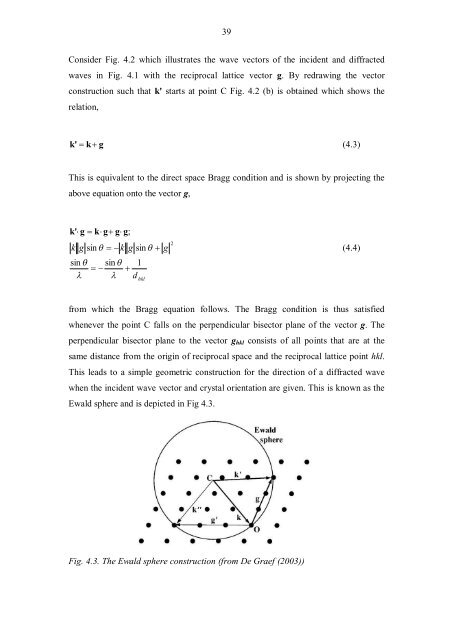Analysis of the extended defects in 3C-SiC.pdf - Nelson Mandela ...
Analysis of the extended defects in 3C-SiC.pdf - Nelson Mandela ...
Analysis of the extended defects in 3C-SiC.pdf - Nelson Mandela ...
Create successful ePaper yourself
Turn your PDF publications into a flip-book with our unique Google optimized e-Paper software.
39<br />
Consider Fig. 4.2 which illustrates <strong>the</strong> wave vectors <strong>of</strong> <strong>the</strong> <strong>in</strong>cident and diffracted<br />
waves <strong>in</strong> Fig. 4.1 with <strong>the</strong> reciprocal lattice vector g. By redraw<strong>in</strong>g <strong>the</strong> vector<br />
construction such that k' starts at po<strong>in</strong>t C Fig. 4.2 (b) is obta<strong>in</strong>ed which shows <strong>the</strong><br />
relation,<br />
k' k<br />
g<br />
(4.3)<br />
This is equivalent to <strong>the</strong> direct space Bragg condition and is shown by project<strong>in</strong>g <strong>the</strong><br />
above equation onto <strong>the</strong> vector g,<br />
k'<br />
g k<br />
g<br />
g<br />
g;<br />
k g s<strong>in</strong> k g s<strong>in</strong> g<br />
s<strong>in</strong> s<strong>in</strong> 1<br />
<br />
d<br />
hkl<br />
2<br />
(4.4)<br />
from which <strong>the</strong> Bragg equation follows. The Bragg condition is thus satisfied<br />
whenever <strong>the</strong> po<strong>in</strong>t C falls on <strong>the</strong> perpendicular bisector plane <strong>of</strong> <strong>the</strong> vector g. The<br />
perpendicular bisector plane to <strong>the</strong> vector ghkl consists <strong>of</strong> all po<strong>in</strong>ts that are at <strong>the</strong><br />
same distance from <strong>the</strong> orig<strong>in</strong> <strong>of</strong> reciprocal space and <strong>the</strong> reciprocal lattice po<strong>in</strong>t hkl.<br />
This leads to a simple geometric construction for <strong>the</strong> direction <strong>of</strong> a diffracted wave<br />
when <strong>the</strong> <strong>in</strong>cident wave vector and crystal orientation are given. This is known as <strong>the</strong><br />
Ewald sphere and is depicted <strong>in</strong> Fig 4.3.<br />
Fig. 4.3. The Ewald sphere construction (from De Graef (2003))

















